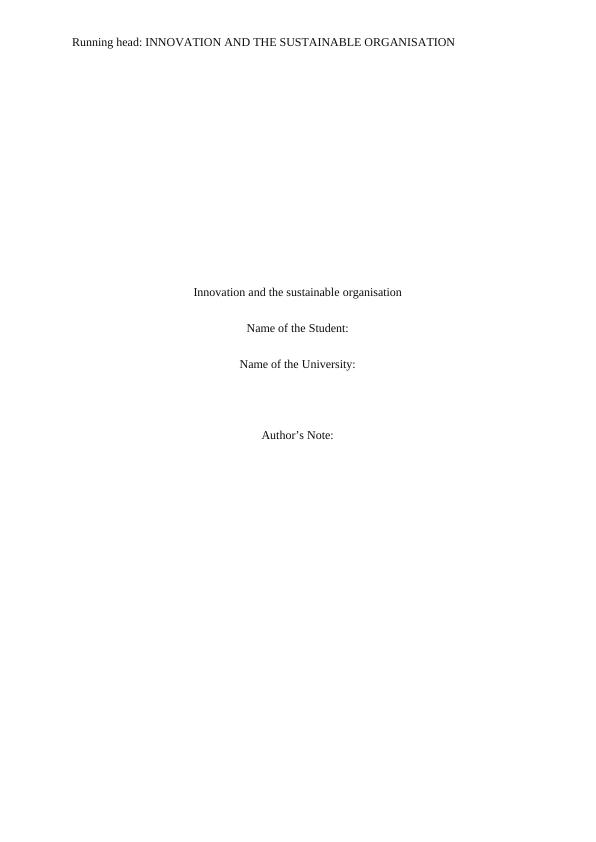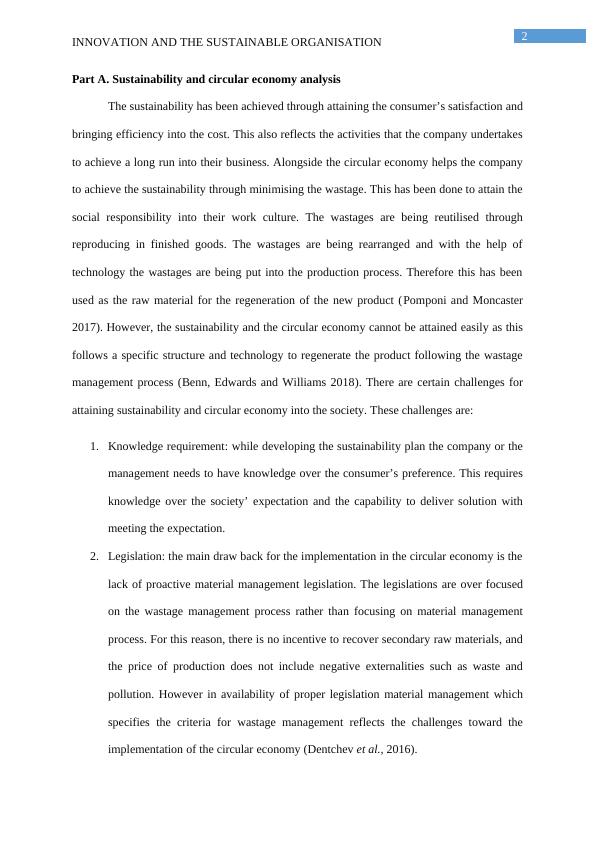Innovation and the Sustainable Organisation
Added on 2023-01-23
14 Pages3457 Words53 Views
Running head: INNOVATION AND THE SUSTAINABLE ORGANISATION
Innovation and the sustainable organisation
Name of the Student:
Name of the University:
Author’s Note:
Innovation and the sustainable organisation
Name of the Student:
Name of the University:
Author’s Note:

1
INNOVATION AND THE SUSTAINABLE ORGANISATION
Table of Contents
Part A. Sustainability and circular economy analysis................................................................2
Part B:.........................................................................................................................................4
Section 2: Environmental Sustainability analysis..................................................................4
Section 3: sustainability strategy to pursue the sustainability................................................5
Section 4.: Stakeholders’ interest...........................................................................................7
Section 5: Sustainability benchmark......................................................................................8
Conclusion................................................................................................................................10
References................................................................................................................................11
INNOVATION AND THE SUSTAINABLE ORGANISATION
Table of Contents
Part A. Sustainability and circular economy analysis................................................................2
Part B:.........................................................................................................................................4
Section 2: Environmental Sustainability analysis..................................................................4
Section 3: sustainability strategy to pursue the sustainability................................................5
Section 4.: Stakeholders’ interest...........................................................................................7
Section 5: Sustainability benchmark......................................................................................8
Conclusion................................................................................................................................10
References................................................................................................................................11

2
INNOVATION AND THE SUSTAINABLE ORGANISATION
Part A. Sustainability and circular economy analysis
The sustainability has been achieved through attaining the consumer’s satisfaction and
bringing efficiency into the cost. This also reflects the activities that the company undertakes
to achieve a long run into their business. Alongside the circular economy helps the company
to achieve the sustainability through minimising the wastage. This has been done to attain the
social responsibility into their work culture. The wastages are being reutilised through
reproducing in finished goods. The wastages are being rearranged and with the help of
technology the wastages are being put into the production process. Therefore this has been
used as the raw material for the regeneration of the new product (Pomponi and Moncaster
2017). However, the sustainability and the circular economy cannot be attained easily as this
follows a specific structure and technology to regenerate the product following the wastage
management process (Benn, Edwards and Williams 2018). There are certain challenges for
attaining sustainability and circular economy into the society. These challenges are:
1. Knowledge requirement: while developing the sustainability plan the company or the
management needs to have knowledge over the consumer’s preference. This requires
knowledge over the society’ expectation and the capability to deliver solution with
meeting the expectation.
2. Legislation: the main draw back for the implementation in the circular economy is the
lack of proactive material management legislation. The legislations are over focused
on the wastage management process rather than focusing on material management
process. For this reason, there is no incentive to recover secondary raw materials, and
the price of production does not include negative externalities such as waste and
pollution. However in availability of proper legislation material management which
specifies the criteria for wastage management reflects the challenges toward the
implementation of the circular economy (Dentchev et al., 2016).
INNOVATION AND THE SUSTAINABLE ORGANISATION
Part A. Sustainability and circular economy analysis
The sustainability has been achieved through attaining the consumer’s satisfaction and
bringing efficiency into the cost. This also reflects the activities that the company undertakes
to achieve a long run into their business. Alongside the circular economy helps the company
to achieve the sustainability through minimising the wastage. This has been done to attain the
social responsibility into their work culture. The wastages are being reutilised through
reproducing in finished goods. The wastages are being rearranged and with the help of
technology the wastages are being put into the production process. Therefore this has been
used as the raw material for the regeneration of the new product (Pomponi and Moncaster
2017). However, the sustainability and the circular economy cannot be attained easily as this
follows a specific structure and technology to regenerate the product following the wastage
management process (Benn, Edwards and Williams 2018). There are certain challenges for
attaining sustainability and circular economy into the society. These challenges are:
1. Knowledge requirement: while developing the sustainability plan the company or the
management needs to have knowledge over the consumer’s preference. This requires
knowledge over the society’ expectation and the capability to deliver solution with
meeting the expectation.
2. Legislation: the main draw back for the implementation in the circular economy is the
lack of proactive material management legislation. The legislations are over focused
on the wastage management process rather than focusing on material management
process. For this reason, there is no incentive to recover secondary raw materials, and
the price of production does not include negative externalities such as waste and
pollution. However in availability of proper legislation material management which
specifies the criteria for wastage management reflects the challenges toward the
implementation of the circular economy (Dentchev et al., 2016).

3
INNOVATION AND THE SUSTAINABLE ORGANISATION
3. Technology and logistics: the sustainability can be achieved through earning
efficiency into cost and gaining effectiveness into the work. However the
effectiveness and cost efficiency can only be earned through the effective use of
technology. Along with that the circular economy can be achieved through the proper
use of technology for the reproduction from the used product with having high
technology for transferring the good from one place to wastage reproduction centre.
This requires fast and expensive transport system with having high technology for the
production process. This remains challenge for many company to acquire major
logistical considerations. This also has been challenge for many companies in
providing satisfaction to their consumer through developing sustainability with the
help of effective use of technology (Baumgartner 2014).
4. Expenses: while developing a sustainability plan, this requires high expenses. This
means that the company needs to spend lots of money in to the public relation activity
to gain a long term relationship with the consumers. While the aim has been made to
develop a sustainability into the consumer’s society this requires high cost spending
as to gain a proper wastage management process.
5. Requirement of training and development: Generating sustainability in to the
consumer’s society requires high consumer’s satisfaction. This can only be done
through providing proper service to the consumer. However for the generation of the
proper and high quality consumer service this requires training and development for
the employees. However, this knowledge base requires training of project managers
and other organizational personnel (Charles Jr, Schmidheiny and Watts 2017).
INNOVATION AND THE SUSTAINABLE ORGANISATION
3. Technology and logistics: the sustainability can be achieved through earning
efficiency into cost and gaining effectiveness into the work. However the
effectiveness and cost efficiency can only be earned through the effective use of
technology. Along with that the circular economy can be achieved through the proper
use of technology for the reproduction from the used product with having high
technology for transferring the good from one place to wastage reproduction centre.
This requires fast and expensive transport system with having high technology for the
production process. This remains challenge for many company to acquire major
logistical considerations. This also has been challenge for many companies in
providing satisfaction to their consumer through developing sustainability with the
help of effective use of technology (Baumgartner 2014).
4. Expenses: while developing a sustainability plan, this requires high expenses. This
means that the company needs to spend lots of money in to the public relation activity
to gain a long term relationship with the consumers. While the aim has been made to
develop a sustainability into the consumer’s society this requires high cost spending
as to gain a proper wastage management process.
5. Requirement of training and development: Generating sustainability in to the
consumer’s society requires high consumer’s satisfaction. This can only be done
through providing proper service to the consumer. However for the generation of the
proper and high quality consumer service this requires training and development for
the employees. However, this knowledge base requires training of project managers
and other organizational personnel (Charles Jr, Schmidheiny and Watts 2017).

End of preview
Want to access all the pages? Upload your documents or become a member.
Related Documents
Report of Any Fashion Brandlg...
|12
|3870
|85
Innovation and Sustainable Organisation (pdf)lg...
|15
|5291
|243
Circular Economy in Kuala Lumpur: Progress, Barriers, and Opportunitieslg...
|14
|4108
|1
Value Dimensional Marketing Assignment 2022lg...
|8
|2174
|9
Critical Review of Global Logisticslg...
|12
|653
|105
Macromarketinglg...
|4
|415
|42
